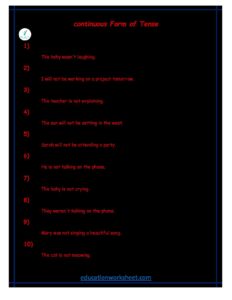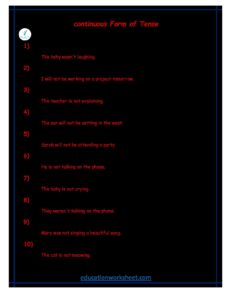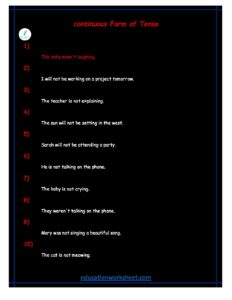how to converting continuous tense positive sentences to negative form
how to converting continuous tense positive sentences to negative form
Introduction to Continuous Tense
Before we dive into transforming continuous tense positive sentences into negative ones, let’s review the basics of the continuous tense in English. The continuous tense is used to describe actions that are ongoing or in progress at a specific point in time. It is typically formed by combining the appropriate form of the verb “to be” with the present participle form of the main verb (verb + -ing).
Here are the different forms of the continuous tense in English:
- Present Continuous:
- Affirmative: Subject + am/is/are + verb-ing
- Negative: Subject + am not/is not (isn’t)/are not (aren’t) + verb-ing
- Past Continuous:
- Affirmative: Subject + was/were + verb-ing
- Negative: Subject + was not (wasn’t)/were not (weren’t) + verb-ing
- Future Continuous:
- Affirmative: Subject + will be + verb-ing
- Negative: Subject + will not (won’t) + be + verb-ing
Converting Continuous Tense Positive Sentences to Negative Form

To transform continuous tense positive sentences into negative ones, we follow a few simple rules:
1. Identify the Verb
First, identify the main verb in the affirmative sentence. This verb is in the present participle form (ending in -ing) for continuous tense.
2. Add “Not” to the Appropriate Form of “To Be”
In the negative form, we add “not” to the appropriate form of the verb “to be” (am, is, are, was, were, will be).
3. Rearrange the Words
After adding “not” to the verb “to be,” rearrange the words to place the negative “not” between the subject and the verb.
4. Maintain the -ing Form of the Main Verb
Ensure that the main verb remains in the present participle form (-ing).
Let’s explore these rules in more detail with examples:
Present Continuous Tense:
Affirmative:
- She is dancing at the party.
- They are playing football.
Negative:
- She is not dancing at the party.
- They are not playing football.
Past Continuous Tense:
Affirmative:
- He was studying all night.
- We were cooking dinner.
Negative:
- He was not studying all night.
- We were not cooking dinner.
Future Continuous Tense:

Affirmative:
- I will be working late.
- You will be traveling tomorrow.
Negative:
- I will not (won’t) be working late.
- You will not (won’t) be traveling tomorrow.
Additional Considerations
- In the case of contracted forms, you can use “isn’t,” “aren’t,” “wasn’t,” “weren’t,” and “won’t” for a more informal tone.
- When transforming sentences, pay attention to the subject-verb agreement. Ensure that the form of “to be” matches the subject (am/is/are for singular, was/were for past, and will be for future).
- Maintain the tense of the main verb in the present participle form (-ing).
Examples
Let’s work through a variety of examples to solidify your understanding of converting continuous tense positive sentences to negative ones:
Present Continuous:
- Affirmative: They are studying for the exam. Negative: They are not studying for the exam.
- Affirmative: I am playing the piano. Negative: I am not playing the piano.
- Affirmative: She is baking a cake. Negative: She is not baking a cake.
Past Continuous:

- Affirmative: He was watching TV. Negative: He was not watching TV.
- Affirmative: We were hiking in the mountains. Negative: We were not hiking in the mountains.
- Affirmative: I was reading a novel. Negative: I was not reading a novel.
Future Continuous:
- Affirmative: They will be attending the conference. Negative: They will not (won’t) be attending the conference.
- Affirmative: She will be giving a presentation. Negative: She will not (won’t) be giving a presentation.
- Affirmative: I will be working on a project. Negative: I will not (won’t) be working on a project.
Common Errors and Pitfalls
When converting continuous tense positive sentences to negative form, there are some common errors and pitfalls to avoid:
1. Subject-Verb Agreement
Ensure that the form of the verb “to be” matches the subject. For example, use “is” with singular subjects (He/She/It), “are” with plural subjects (They/We/You), and “was” or “were” as appropriate for the past tense.
2. Maintaining the -ing Form
Don’t forget to maintain the present participle form of the main verb (-ing). This is a critical aspect of continuous tense.
3. Proper Usage of Contractions
While contractions like “isn’t,” “aren’t,” “wasn’t,” “weren’t,” and “won’t” are commonly used in spoken English, ensure that their use is appropriate for the context and formality of your writing or speech.

